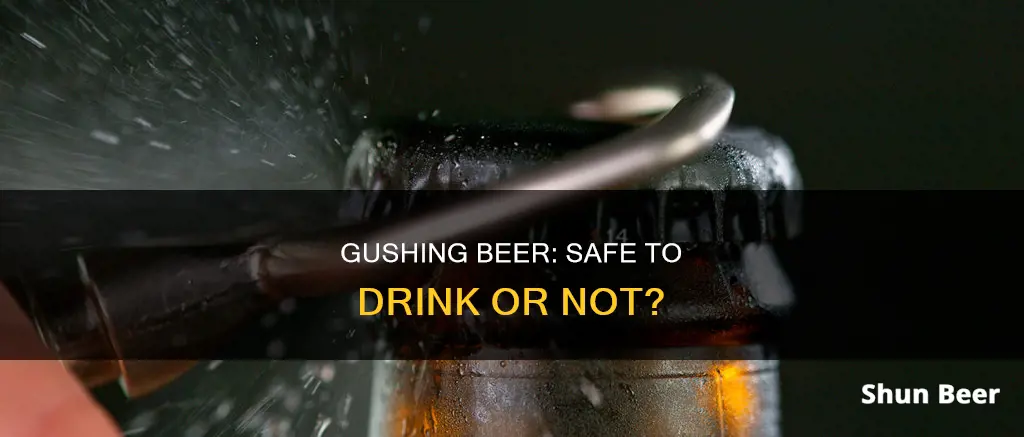
Gushers, or gushing, is the occurrence of vigorous overflowing of beer upon opening the bottle or can. While it may be startling, it is generally considered safe to drink a gushing beer. However, it is important to use caution as it could indicate a bacterial infection. The most common cause of gushing is the presence of a protein called hydrophobin, which is created by a fungus that infects malt grains during the brewing process. This protein attracts carbon dioxide molecules to the surface of the liquid, and when the bottle is opened, the carbon dioxide escapes rapidly, causing the beer to overflow. Other causes of gushing include agitation, fermentation issues, the presence of foreign particles, and barley fungus. While it is unlikely that drinking a gushing beer will cause harm, it is recommended to use caution if the beer smells or tastes unpleasant.
| Characteristics | Values |
|---|---|
| Is it safe to drink? | Yes, it is safe to drink. Harmful bacteria cannot survive in beer. |
| Why does it gush? | It could be due to several factors, including agitation, fermentation issues, rogue particles, barley fungus, or bacterial infection. |
| How to prevent it? | Brewers can add extra hops or use magnets to prevent the formation of foam. |
What You'll Learn

Is gushing beer safe to drink?
Gushing beer is generally safe to drink, but it may be an indicator of a larger issue.
Gushing, or fobbing, is the vigorous overflowing of beer upon opening the bottle or can. This is caused by the rapid release of gas in the beer, which is usually carbon dioxide. This can be caused by agitation, such as shaking or dropping the beer, or by fermentation issues, such as too much sugar being added, allowing the yeast to create too much carbon dioxide. It can also be caused by the presence of particulates, or nucleation sites, which attract carbon dioxide molecules, causing them to gather and be released very rapidly when the bottle or can is opened.
Gushing beer is usually safe to drink, but it may indicate that the beer is infected. In most cases, harmful bacteria cannot survive in beer due to its alcohol content and acidic, hoppy environment. However, if the gushing is caused by bacterial infection, it could result in off-flavours or an increase in alcohol content. If the beer smells or tastes sour or vinegary, it is best to discard it.
To prevent gushing, brewers can add extra hops to the beer, as they act as an anti-foaming agent. Additionally, ensuring that bottles and cans are clean and free of debris before filling can help to reduce the occurrence of gushing.
Wisconsin Park Beer Rules: What You Need to Know
You may want to see also

What causes gushing?
Gushing, also known as fobbing, is the overflowing of beer upon opening the bottle or can. It is caused by the rapid release of gas in beer. This happens when there are particulates that form sites for carbon dioxide to gather, which are called nucleation sites.
There are two types of gushing: primary gushing and secondary gushing. Primary gushing is attributed to beers brewed from defective malt, which is derived from barley harvested under wet conditions. The substances responsible for primary gushing are hydrophobic polypeptides derived from several mould strains, most commonly denoted as Fusarium. Fusarium is a fungus that arises as a blight on numerous grains during pre-harvest rains or from storing them incorrectly in damp places. If the malt used to brew the beer comes from barley or wheat infected with the fungus, it will contain proteins called hydrophobins, which form microscopic capsules where the CO2 is retained under pressure. When the beer is opened, the gas is released and spills out in the form of foam.
Secondary gushing includes, but is not limited to, the presence of metal ions such as iron, nickel, and tin; calcium oxalate; some isomerized hop extracts; a rough surface (forming the nucleation sites) on the inside of the bottle; and inadequate washing and rinsing of bottles prior to filling. Calcium oxalate can also be an issue. Oxalate anions, derived from the husks of the grains used in brewing, can precipitate out with calcium and form distinct crystals, which form the seeds or nucleation sites for CO2 breakout.
Beer Consumption: Which State Drinks the Most?
You may want to see also

Is gushing a sign of bacterial infection?
Gushing is the vigorous overflowing of beer from a bottle or can upon opening. While gushing is generally not harmful, it can be a sign of bacterial infection.
Causes of Gushing
Gushing can be attributed to several factors, which can be categorised into two types: primary gushing and secondary gushing.
Primary Gushing
Primary gushing is caused by beers brewed from defective malt, usually derived from barley harvested in cold and wet conditions. The specific substance responsible for primary gushing is hydrophobic polypeptides, which are produced by several mould strains, most commonly Fusarium. Other fungal species that can cause primary gushing include Aspergillus, Rhizopus, Penicillium, and Nigrospora.
Secondary Gushing
Secondary gushing is caused by a variety of factors, including:
- Metal ions such as iron, nickel, and tin
- Calcium oxalate
- Some isomerised hop extracts
- Rough surfaces on the inside of the bottle
- Inadequate washing and rinsing of bottles prior to filling
- Over-carbonation
- Bottle conditioning
Signs of Bacterial Infection
While gushing can be a sign of bacterial infection, it is not always indicative of one. Other signs that may indicate a bacterial infection include:
- The formation of a pellicle on the surface of the beer, which is created by Brettanomyces and various lactic acid bacteria
- A persistent off-flavour that continues to appear in every batch
- Continuous over-attenuation, where a wild yeast continues to ferment batches beyond the desired level of attenuation
Preventing and Reducing Gushing
To prevent and reduce gushing, several methods can be employed, including:
- Biological methods: Applying lactic acid bacteria or yeast to barley in the field or during the malting process to reduce fungal infection
- Physical methods: Ensuring uninfected barley and malt in the beer production chain through strict in-house quality control of raw materials
- Mixing different malt batches to reduce gushing potential
- Membrane filtration and pasteurisation: Membrane filtration (0.1 µm pore size) and pasteurisation at 60 °C can help reduce gushing
- Magnetic field application: Applying a magnetic field to disperse hop extract has been found to decrease gushing
- Ultrasonic vibrations: Ultrasonic vibrations can calm the disturbed liquid prone to gushing by changing the number and size distribution of microbubbles
- Addition of different compounds: Treating barley with hydrogen peroxide or hot water can reduce fungal infection; adding calcium-rich silicates can also reduce gushing without affecting the sensory properties of the beer
- Enzyme addition: Adding proteolytic enzymes to wort can degrade hydrophobins and plant proteins, reducing the gushing phenomenon
- Hop compounds: Adding hop components such as free linalool and humulones can decrease gushing potential
While gushing can be a sign of bacterial infection, it is not always indicative of one. There are several factors that can cause gushing, and it is important to identify the specific cause to implement effective prevention and reduction methods.
Monkeys and Beer: A Safe Combination?
You may want to see also

What does gushing beer taste like?
Gushing beer is generally safe to drink, although it may taste bad. The worst thing that can happen is that the beer tastes bad due to the presence of bacteria in the beer, but this is unlikely to make you sick. In fact, harmful bacteria cannot survive in beer.
Gushing beer is caused by the rapid release of gas in the beer, which is promoted by anything that causes the gas to be released very rapidly. This includes agitation, such as shaking or dropping the bottle, and the presence of particulates that form nucleation sites for carbon dioxide to gather. These nucleation sites cause the gas to be released very quickly when the bottle is opened, resulting in the gushing effect.
The taste of gushing beer can vary depending on the cause of the gushing. For example, if the gushing is due to fermentation issues, such as too much sugar being added to the bottle, the beer may have a sweeter taste. If the gushing is caused by the presence of rogue particles or nucleation sites, the beer may taste different due to the interaction of these particles with the beer. Additionally, if the gushing is caused by barley fungus, the beer may have a slightly different taste due to the presence of hydrophobins, which are proteins created by the fungus.
Overall, while gushing beer is generally safe to drink, the taste may be affected by the various factors that contribute to the gushing. These factors can include agitation, fermentation issues, the presence of rogue particles, and barley fungus, each of which can impact the flavour of the beer in different ways.
Sober People and Non-Alcoholic Beer: A Safe Choice?
You may want to see also

How to prevent gushing
Gushing, also known as fobbing, is the vigorous overflowing of beer upon opening the bottle or can. It is caused by the rapid release of gas in the beer. Gushing is attributed to "primary gushing" and "secondary gushing".
Primary gushing is attributed to beers brewed from defective malt (derived from barley harvested under wet conditions). The substances responsible for gushing are hydrophobic polypeptides derived from several mould strains—most commonly those denoted as Fusarium.
To prevent primary gushing, brewers need to control the quality of the malt.
Secondary gushing includes but is not limited to:
- The presence of metal ions such as iron, nickel, and tin
- Calcium oxalate
- Some isomerized hop extracts
- A rough surface (forming nucleation sites) on the inside of the bottle
- Inadequate washing and rinsing of bottles prior to filling
- Overcarbonation
- Overattenuation or overpriming of bottle-conditioned beer
To prevent secondary gushing, brewers need to remove other potential nucleation materials. The treatment of beer with adsorbents and tight filtration can help. Brewers should also minimize iron content from brewing water and/or DE filtration medium (leaching caused by reverse flow) and analyze variety-dependent hop alpha-acid/polyphenol ratios.
Did Jesus' Disciples Drink Beer? Exploring Ancient Beverage Choices
You may want to see also
Frequently asked questions
Yes, it is safe to drink gushing beer. Harmful bacteria cannot survive in beer.
There are several factors that can cause beer to gush. One of the most common causes is simple agitation, such as shaking the bottle or clinking bottles together before opening. Other causes include fermentation issues, the presence of foreign particles, and the use of defective malt contaminated by mould strains such as Fusarium.
To prevent beer from gushing, avoid agitating the bottle before opening and ensure that it has not been shaken or dropped. Additionally, brewers can add extra hops to the beer, as hops act as an antifoaming agent that prevents proteins from binding with carbon dioxide.
If you experience a gusher, smell the beer first. If it smells like vinegar, dump it. If it smells fine, taste it, and if it tastes normal, it is safe to drink.
While it is unlikely that drinking gushing beer will make you sick, there is a small risk of bacterial infection. However, the main concern is usually the waste of beer and the mess caused by the overflow.







